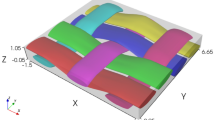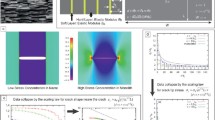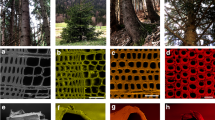Summary
-
1.
For mature animals where all fractions of the cuticle have a high insoluble protein content, the outer fraction is notably brittle while the middle and inner fractions exhibit extensive plastic flow on tensile deformation.
-
2.
The composite tensile behaviour ofLimulus cuticle can be adequately described in terms of a simple law of mixtures where the three fractions are held together by means of a brittle glue at their interfaces.
-
3.
No significant differences were observed between the alcohol-preserved material and specimens of fresh whole cuticle in terms of mechanical behaviour where both have equal amounts of insoluble protein.
-
4.
The fracture behaviour of the whole cuticle is biologically analogous to case-hardened engineering materials.
-
5.
None of the available histological criteria for distinguishing individual components of the cuticle were useful as indicators of either the extent of tanning of the mechanical properties ofLimulus cuticle.
-
6.
All the protein in the cuticle ofLimulus becomes stabilized by cross-linking, and this process is important both in making the protein insoluble and in determining the mechanical properties of the cuticle.
Similar content being viewed by others
References
Andersen, S. O.: Comparison between the sclerotization of adult and larval cuticle inSchistocerca gregaria. J. Insect Physiol.19, 1603–1614 (1973)
Andersen, S. O.: Cuticular sclerotization in larval and adult locusts,Schistocerca gregaria. J. Insect Physiol.20, 1537–1552 (1974a)
Andersen, S. O.: Evidence for two mechanisms of sclerotization in insect cuticle. Nature (Lond.)251, 507–508 (1974b)
Andersen, S. O., Barrett, F. M.: The isolation of ketocatechols from insect cuticle and their possible role in sclerotization. J. Insect Physiol.17, 69–83 (1971)
Cutler, B., Richards, A. G.: Sclerotization and the localization of brown and black colors in chelicerates (Arthropoda). Zool. Jb. Anat.89, 404–421 (1972)
Hearmon, R. F. S., Barkas, W.: The effect of grain direction on the Young's moduli and rigidity moduli of beech and sitka spruce. Proc. phys. Soc.53, 674–680 (1941)
Hepburn, H. R.: Some mechanical properties of crossed fibrillar chitin. J. Insect Physiol.18, 815–825 (1972)
Hepburn, H. R., Ball, A.: On the structure and mechanical properties of beetle shells. J. Materials Sci.8, 618–623 (1973)
Hepburn, H. R., Joffe, I.: Hardening of locust sclerites. J. Insect Physiol.20, 631–635 (1974a)
Hepburn, H. R., Joffe, I.: Locust solid cuticle — a time sequence of mechanical properties. J. Insect Physiol.20, 497–506 (1974b)
Joffe, I., Hepburn, H. R.: Observations on regenerated chitin films. J. Materials Sci.8, 1751–1754 (1973)
Joffe, I., Hepburn, H. R., Nelson, K. J., Green, N.: Mechanical properties of a crustacean exoskeleton. Comp. Biochem. Physiol.50A, 545–549 (1975)
Karlson, P., Sekeri, K. E., Richards, A. G., Richards, P. A.: The amino acid composition of the various types of cuticle ofLimulus polyphemus. J. Insect Physiol.15, 495–507 (1969)
Larsen, N. J.: Isolation and characterization of proteins from the cuticle ofLimulus polyphemus L. Comp. Biochem. Physiol., in press (1975)
Neville, A. C.: Cuticle ultrastructure in relation to the whole insect. Symp. R. ent. Soc. Lond.5, 17–39 (1970)
Neville, A. C., Thomas, M. G., Zelazny, B.: Pore canal shape related to molecular architecture of arthropod cuticle. Tissue & Cell1, 183–200 (1969)
Richards, A. G.: The integument of arthropods. Minneapolis: University of Minnesota Press 1951
Richards, A. G.: Sclerotization and the localization of brown and black colors in insects. Zool. Jb. Anat.84, 25–62 (1967)
Welinder, B. S.: Halogenated tyrosines from the cuticle ofLimulus polyphemus (L.). Biochem. biophys. Acta (Amst.)279, 491–497 (1972)
Author information
Authors and Affiliations
Rights and permissions
About this article
Cite this article
Joffe, I., Hepburn, H.R. & Andersen, S.O. On the mechanical properties ofLimulus solid cuticle. J Comp Physiol B 101, 147–160 (1975). https://doi.org/10.1007/BF00694155
Received:
Issue Date:
DOI: https://doi.org/10.1007/BF00694155




